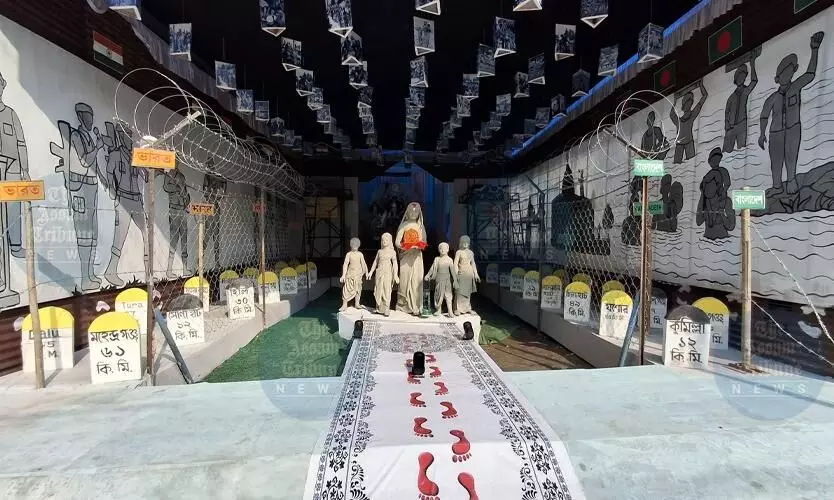
Dhubri, Oct 11: In the vibrant atmosphere of Durga Puja celebrations, the pandal at Balurchar Ward No. 3 in Dhubri has emerged as a unique centre of attention, captivating visitors with its powerful depiction of historical and modern-day struggles faced by Hindus in Bangladesh.
This year, the 3 No. Balurchar Sarbajonin Durga Puja Committee has taken an emotional and thought-provoking approach, drawing attention to the atrocities committed against Hindus in Bangladesh, particularly during the recent student movement in the neighbouring country.
Through carefully designed artistic displays and installations, the pandal brings to life a striking narrative that speaks not only to historical events but also to the ongoing plight of minority Hindus in Bangladesh. One of the central themes of the pandal is the historic transportation of the Dhakeshwari idol from Dhaka to Kolkata during the Partition of India in 1947—a symbolic journey that reflects the pain, displacement, and survival of millions of Hindus who fled East Bengal, now Bangladesh, amid the chaos of partition.
Janardhan Paul, a member of the 3 No. Balurchar Sarbajonin Durga Puja Committee, explained the significance of this portrayal. "The original 900-year-old Dhakeshwari idol, an incarnation of Goddess Durga, was taken to Kumartuli, Kolkata, from Dhaka during the partition. This idol became a symbol of resilience and faith for the Bengali Hindus who were forced to leave their homes in East Bengal due to the violence and persecution that followed the Partition of Bengal in 1947."
The partition itself, a watershed moment in South Asian history, saw the mass migration of millions of people across the newly drawn borders of India and Pakistan. For the Hindu community of East Bengal, the Dhakeshwari temple in Dhaka, dedicated to the Mother Goddess Durga, was a beacon of spiritual and cultural significance. However, in the wake of partition, as communal tensions and violence swept through the region, many Hindu families were forced to flee. The transportation of the Dhakeshwari idol to Kolkata, West Bengal, became a powerful act of preservation, ensuring that the legacy of the deity and her devotees would survive in a land that offered them safety and hope.
In the Balurchar pandal, visitors are taken through a symbolic journey where the Dhakeshwari idol, carried by refugees, traverses the perilous road from Dhaka to Kolkata—a poignant reminder of the struggles faced by those who were displaced. The visuals capture the essence of fear, loss, and determination, showing how the Goddess, much like her followers, found a new home in a different land.
But the story doesn’t stop with history. The pandal also draws parallels between the events of 1947 and the recent surge of violence against Hindus in Bangladesh during the student movement, where Hindus were targeted in communal riots. In the past few years, Bangladesh has seen a rise in religious intolerance, with minorities often bearing the brunt of political and social unrest. Through this depiction, the Balurchar Puja Committee is giving a voice to the voiceless, raising awareness about the plight of Hindus who continue to face persecution in the region.
The intricate artwork and craftsmanship of the pandal have impressed visitors, who see it not only as a place of worship but also as an educational experience that connects the dots between past and present struggles. "This year’s theme resonates deeply with us," said a local visitor. "It reminds us that while we celebrate Durga Puja with joy and festivity, there are communities whose connection to the Goddess has been marked by suffering and displacement."
The Dhakeshwari idol, now housed in Kumartuli, Kolkata, is a symbol of that connection. Though she no longer resides in her original temple in Dhaka, she continues to be worshipped by Bengali Hindus, representing the endurance of faith amid the trials of history.
This unique initiative by the Committee has not only enriched the spiritual experience of the festival but has also sparked conversations about the historical trauma of partition and the ongoing marginalisation of minorities in South Asia. By blending art, history, and religion, the pandal at Balurchar has become a poignant reminder of the challenges faced by Hindu communities in Bangladesh, past and present.
The Dhubri pandal stands as a testament to the enduring spirit of the Hindu community, highlighting the resilience of those who, despite persecution, hold on to their faith and culture. As thousands flock to witness the beauty and message of the Balurchar Durga Puja, they are reminded of the larger narrative of survival, migration, and the continuing fight for justice for Hindus in Bangladesh.
